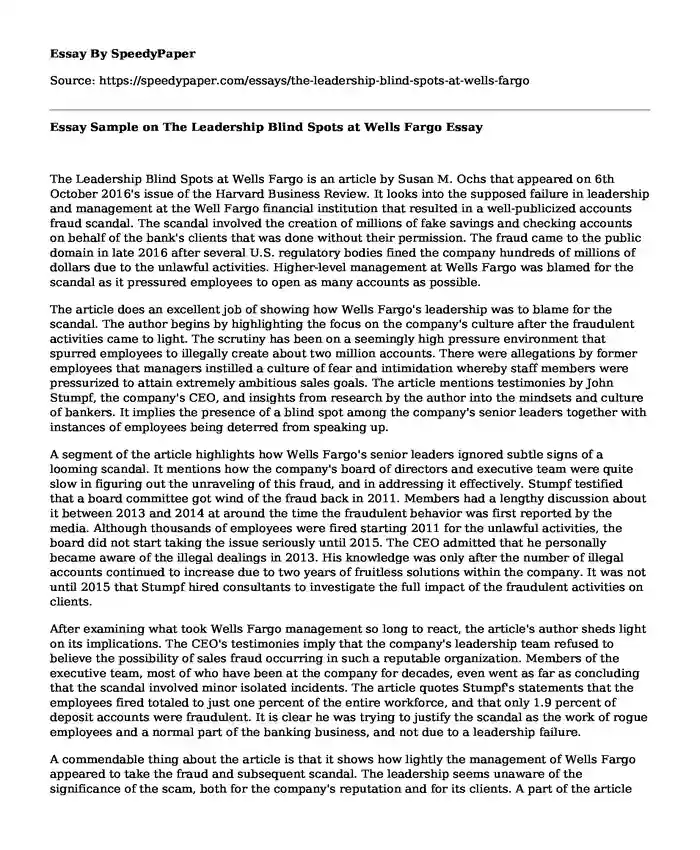The Leadership Blind Spots at Wells Fargo is an article by Susan M. Ochs that appeared on 6th October 2016's issue of the Harvard Business Review. It looks into the supposed failure in leadership and management at the Well Fargo financial institution that resulted in a well-publicized accounts fraud scandal. The scandal involved the creation of millions of fake savings and checking accounts on behalf of the bank's clients that was done without their permission. The fraud came to the public domain in late 2016 after several U.S. regulatory bodies fined the company hundreds of millions of dollars due to the unlawful activities. Higher-level management at Wells Fargo was blamed for the scandal as it pressured employees to open as many accounts as possible.
The article does an excellent job of showing how Wells Fargo's leadership was to blame for the scandal. The author begins by highlighting the focus on the company's culture after the fraudulent activities came to light. The scrutiny has been on a seemingly high pressure environment that spurred employees to illegally create about two million accounts. There were allegations by former employees that managers instilled a culture of fear and intimidation whereby staff members were pressurized to attain extremely ambitious sales goals. The article mentions testimonies by John Stumpf, the company's CEO, and insights from research by the author into the mindsets and culture of bankers. It implies the presence of a blind spot among the company's senior leaders together with instances of employees being deterred from speaking up.
A segment of the article highlights how Wells Fargo's senior leaders ignored subtle signs of a looming scandal. It mentions how the company's board of directors and executive team were quite slow in figuring out the unraveling of this fraud, and in addressing it effectively. Stumpf testified that a board committee got wind of the fraud back in 2011. Members had a lengthy discussion about it between 2013 and 2014 at around the time the fraudulent behavior was first reported by the media. Although thousands of employees were fired starting 2011 for the unlawful activities, the board did not start taking the issue seriously until 2015. The CEO admitted that he personally became aware of the illegal dealings in 2013. His knowledge was only after the number of illegal accounts continued to increase due to two years of fruitless solutions within the company. It was not until 2015 that Stumpf hired consultants to investigate the full impact of the fraudulent activities on clients.
After examining what took Wells Fargo management so long to react, the article's author sheds light on its implications. The CEO's testimonies imply that the company's leadership team refused to believe the possibility of sales fraud occurring in such a reputable organization. Members of the executive team, most of who have been at the company for decades, even went as far as concluding that the scandal involved minor isolated incidents. The article quotes Stumpf's statements that the employees fired totaled to just one percent of the entire workforce, and that only 1.9 percent of deposit accounts were fraudulent. It is clear he was trying to justify the scandal as the work of rogue employees and a normal part of the banking business, and not due to a leadership failure.
A commendable thing about the article is that it shows how lightly the management of Wells Fargo appeared to take the fraud and subsequent scandal. The leadership seems unaware of the significance of the scam, both for the company's reputation and for its clients. A part of the article mentions a statement by Stumpf that the bank initially did not realize that clients could be charges transaction fees for the fake accounts. He goes on to say that when they finally figured out the harm to clients in 2015, the board of directors began taking stringent measures.
According to the article's author, the above statement by the company's CEO suggests that the only impact on clients is monetary -in the form of wrongful transaction fees. The management thought that thousands of their employees were merely violating clients' trust by stealing identities, falsifying signatures, and discretely moving funds. However, this was not enough harm to spurt the board to take immediate action on the issue. Such misjudgment was probably due to the bank's management taking the incidents. It explains why the board took interest in the fraudulent activities so late in the process, and why it failed to take disciplinary action until the fraud received media coverage. Top-level managers seemed only interested in the financial impact of the scandal and not on the ethical violations.
In The Leadership Blind Spots at Wells Fargo, the author does a good job of unraveling the Wells Fargo accounts fraud scandal. The article clearly outlines how the company's top leadership was squarely to the blame for fraudulent activities. The managers pressurized their subordinates to try and make unrealistic sales through coordination and intimidation. Consequently, the staff had to resort to illegal activities in order to satisfy the sales demands.
Work Cited
Ochs, Susan. "The Leadership Blind Spots at Wells Fargo." Harvard Business Review, Harvard Business School Publishing, 6 Oct 2016, https://hbr.org/2016/10/the-leadership-blind-spots-at-wells-fargo
Cite this page
Essay Sample on The Leadership Blind Spots at Wells Fargo. (2023, Mar 26). Retrieved from https://speedypaper.net/essays/the-leadership-blind-spots-at-wells-fargo
Request Removal
If you are the original author of this essay and no longer wish to have it published on the SpeedyPaper website, please click below to request its removal:
- Polyglots Definition Essay Samples
- Free Essay on Biostatistics and Epidemiology
- The Great Gatsby and Its Resonance Today, Literary Essay Sample
- Free Essay about Ordung - Screenplay Analysis
- Essay Sample about Leadership Experiences
- Essay Example Comprising the Math Lesson Plan
- Essay Sample on Customer Service in Airline
Popular categories





